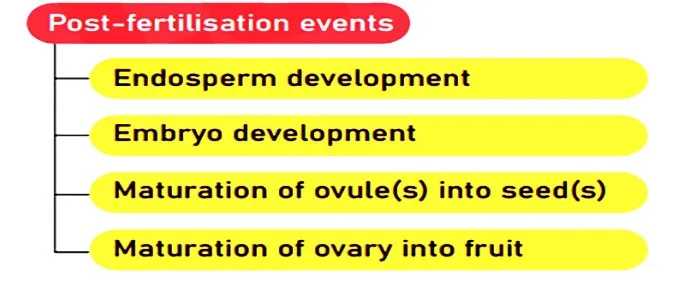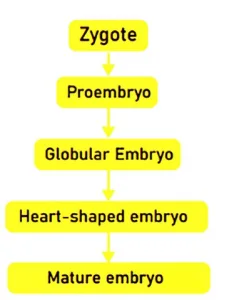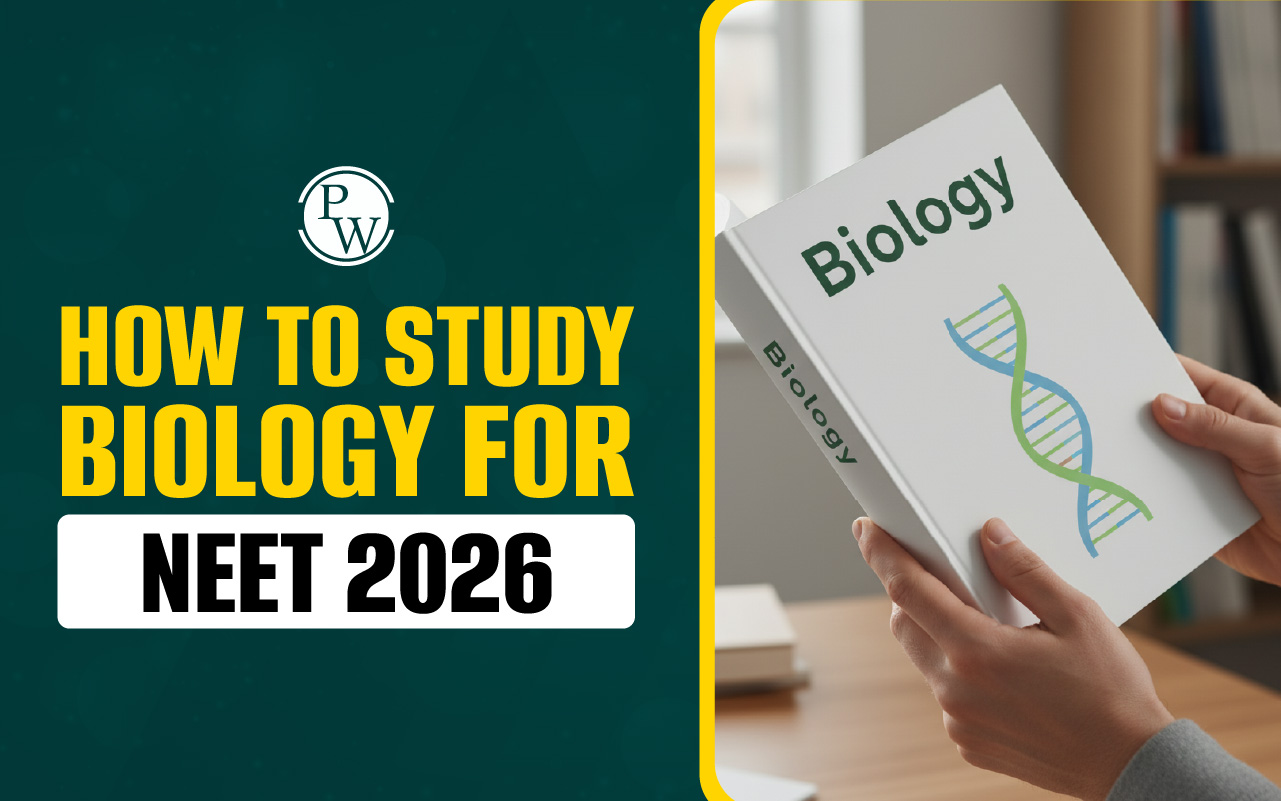
Post Fertilisation- Structures And Events: Pollen grains produce two male gametes in angiospermic plants. A single male gamete fuses with the egg cell to produce fertilisation and a diploid zygote. The other male gamete and two polar nuclei fuse simultaneously to form a triploid primary endosperm nucleus (PEN). Triple fusion is the name given to this process, which combines three haploid nuclei. After zygote formation, post fertilisation processes occur.
After that, a process known as embryogeny occurs when the zygote divides to become an embryo. The endosperm, which provides nutrition for seed development, is produced by division of the primary endosperm nucleus. post fertilisation events are defined as any changes that occur after seed development and before fruit formation. Read this article to learn about the post fertilisation structure and events from the important chapter on sexual reproduction in flowering plants .
Post Fertilisation - Structures and Events in Flowering Plants
Post fertilisation events are those that occur after zygote formation in sexual reproduction. This stage is essential to the embryo's growth and survival, leading to healthy progeny birth. A variety of cellular and molecular processes, including signaling pathways and gene activation, contribute to embryonic cell differentiation and specialization. Fertilisation modifies a plant's reproductive system, resulting in fruit development. The post fertilisation changes in a flower are divided into four major stages:
- Formation of Endosperm
- Development of the embryo
- Development of ovules into seeds
- Ovary matures into a fruit.
Post Fertilisation- Structures And Events include important events that raise questions in the NEET exam. Candidates preparing for NEET should refer to this article for the topic Post Fertilisation- Structures and Events from the class 12 chapter on sexual reproduction in flowering plants.
Flower – A Fascinating Organ of Angiosperms
Post Fertilisation Events in Flowering Plants
Post fertilisation events refer to all sexual reproduction events that occur after fertilisation, that is, after the formation of a zygote. The following are the events that occur in flowering plants after fertilisation.

Pre Fertilisation – Structures And Events
Formation of Endosperm
The endosperm is a specialized tissue found in the seeds of flowering plants during seed development. It contains reserve food materials that nourish the developing embryo, typically in the form of starch. Endosperm development is categorized into three main types:
- Nuclear endosperm formation: This process creates free nuclei without the need for the development of cell walls by repeatedly dividing the primary nucleus.
- Cellular endosperm formation: Nuclear division is followed by cell formation, leading to the development of cellular endosperm. This type is observed in coconut meat.
- Helobial endosperm formation: This is an intermediate type of endosperm development, exhibiting characteristics of both cellular and nuclear endosperm formation.
During seed maturation or upon germination, the developing embryo may either completely consume the endosperm or rely on it for nutrition.
Sexual Reproduction in Flowering Plants MCQ
Embryo Development
Embryogenesis is the process by which a zygote develops into an embryo.

Embryogeny in Dicot Plants
In most angiosperm families, endosperm formation begins before the zygote divides. The zygote divides into two unequal cells:
- Suspensor Cell:
- Location: Towards the micropyle end.
- Development: Undergoes several transverse divisions, forming a filamentous suspensor of 6-10 cells.
- Specialization: The first cell towards the micropyle end swells and functions as a haustorium.
- Embryonal Cell:
- Location: Towards the antipodal region.
- Development: Undergoes two vertical and one transverse division, forming eight cells in two tiers (epibasal and hypobasal).
- Epibasal Tier: Forms two cotyledons and a plumule.
- Hypobasal Tier: Produces hypocotyl except for its tip.
Structure of Dicot Embryo
- Components: Consists of an embryonal axis (tigellum) and two cotyledons.
- Tigellum Parts: Epicotyl (above cotyledons, with plumule as its tip) and hypocotyl (below cotyledons, with radicle as its tip).
Embryogeny in Monocots
Embryogeny in monocots, like Luzula forsteri, follows the Sagittaria type:
Zygote Development:
- Elongation and Transverse Division: Zygote elongates and divides transversely, producing a suspensor cell and an embryo cell.
- Further Division: The embryo cell divides transversally into a top and a middle cell, and the terminal cell divides vertically and transversally, forming globular embryos.
Structure of Monocot Embryo
Components: Monocots have a single cotyledon (scutellum), an embryonal lower axis with a radicle and root cap enclosed in a coleorhiza sheath, and an epicotyl above the scutellum.
- Coleorhiza: Encloses the root cap which is an embryonal lower axis called as radicle.
- Coleoptile: Encloses the shoot apex with a hollow foliar structure called the coleoptile, which protects the plumule region.
Development of Ovules Into Seeds
Seed is the product of fertilized ovule found inside fruits, resulting from sexual reproduction. It comprises seed coat(s), cotyledon(s), and an embryo axis. Cotyledons are typically thick and swollen, storing food, as in legumes. There are two types of mature seeds:
- Non-albuminous seeds: These lack residual endosperm, which is fully utilized during embryo development (e.g., pea, groundnut, beans).
- Albuminous seeds: These retain some endosperm, which is not entirely consumed during embryo development (e.g., wheat, maize, barley, castor, coconut, sunflower).
Some seeds, like black pepper and beet, may also retain remnants of the nucellus, known as perisperm. The integuments of ovules harden to form tough, protective seed coats, with a small pore (micropyle) allowing entry of oxygen and water during germination. As seeds mature, their water content decreases, reaching a dry state (10-15% moisture by mass). The embryo's metabolic activity slows, and it may enter a state of dormancy, germinating under favorable conditions.
Advantages of Seeds
- Seed formation is independent of water, making it a dependable process.
- Seeds have adaptive strategies for dispersal to new habitats, aiding species colonization.
- They contain food reserves, nourishing young seedlings until they can photosynthesize.
- Hard seed coats protect the embryo.
- Seeds generate new genetic combinations through sexual reproduction, leading to variations.
- Dehydration and dormancy allow seeds to be stored for extended periods, providing food year-round and enabling crop cultivation in the next season.
Seed Viability
Some seeds lose viability within months, while others remain viable for several years. Some seeds can remain alive for hundreds of years, with the oldest recorded germination being a lupine seed after 10,000 years of dormancy. Another example is a 2000-year-old viable date palm seed discovered near the Dead Sea.
Development of Fruit from Ovary
The ovary transforms into a fruit, concurrently with ovule-to-seed transformation. The ovary wall becomes the pericarp (fruit wall). Fruits can be fleshy (e.g., guava, orange, mango) or dry (e.g., groundnut, mustard). There are two types of fruits:
- True fruits: Develop only from the ovary, with other floral parts degenerating (e.g., pea, groundnuts, beans).
- False fruits: Thalamus also contributes to fruit formation (e.g., apple, strawberry, cashew).
In some cases, fruits develop without fertilisation, known as parthenocarpy (e.g., banana), which can be induced by growth hormones, resulting in seedless fruits.
Physics Wallah's is the best online coaching for NEET Class 12 candidates. PW NEET Class 12 courses prepare Class 12 candidates for the NEET test by providing quality study materials. Join today for the best NEET preparation.
| NEET Exam Important Links | |
|---|---|
| NEET Biology Syllabus | NEET Biology Diagrams |
| NEET Biology MCQ | NEET Biology Chapter wise Weightage |
| NEET Biology Notes | NEET Previous Year Question papers |
Post Fertilisation- Structures And Events FAQs
What events occur after fertilisation?
What is the initial event after fertilisation?
What is the role of endosperm in post fertilisation development?
What are the post fertilisation structures and events in Class 12?
What events occur after fertilisation in humans in Class 12?










